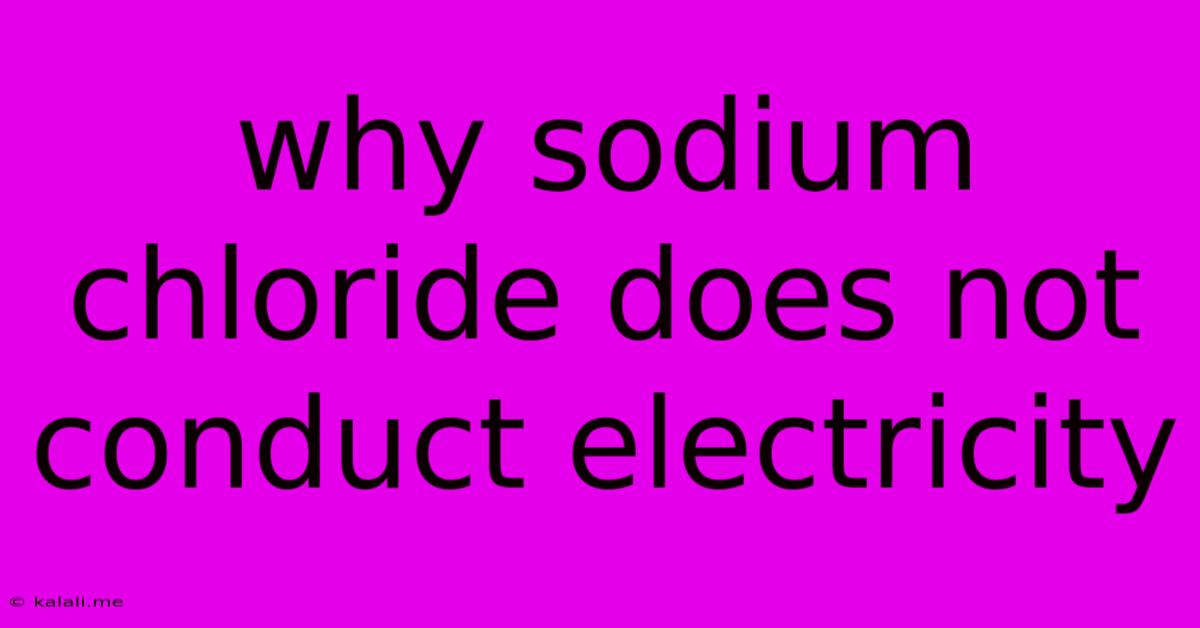Why Sodium Chloride Does Not Conduct Electricity
Kalali
May 22, 2025 · 2 min read

Table of Contents
Why Sodium Chloride Doesn't Conduct Electricity (Unless...)
Meta Description: Discover why solid sodium chloride (table salt) is an insulator, while its dissolved or molten state becomes a conductor. This article explores the role of ion mobility in electrical conductivity.
Sodium chloride, or common table salt, is a fascinating substance. While we know it's crucial for our bodies and used extensively in cooking, many are surprised to learn that in its solid state, it's actually an electrical insulator, meaning it doesn't conduct electricity. This contrasts sharply with its behavior when dissolved in water or melted. This article delves into the reasons behind this seemingly contradictory behavior.
The Role of Ions in Electrical Conductivity
Electrical conductivity depends on the presence of charged particles, called ions, that are free to move. These ions carry the electric current. In materials like metals, electrons are these mobile charge carriers. However, in ionic compounds like sodium chloride (NaCl), the charge carriers are ions themselves.
Why Solid NaCl is an Insulator
In a crystal lattice of solid NaCl, sodium (Na⁺) and chloride (Cl⁻) ions are held together by strong ionic bonds. These ions are arranged in a regular, three-dimensional structure. Crucially, they are fixed in their positions within this lattice. While they carry electrical charge, their immobility prevents them from moving freely to conduct electricity. Think of it like soldiers standing rigidly in formation; they have the potential for movement, but their fixed positions prevent any significant flow. Therefore, solid sodium chloride acts as an insulator.
The Transformation: Dissolved or Molten NaCl
The situation changes drastically when sodium chloride is dissolved in water or melted.
-
Dissolution in Water: When NaCl dissolves in water, the water molecules surround the Na⁺ and Cl⁻ ions, weakening the ionic bonds and effectively separating them. These ions become hydrated, meaning they're surrounded by water molecules, and are now free to move independently within the solution. This mobility allows them to carry an electric current, making the solution a good conductor. The process is called electrolytic dissociation.
-
Melting: Similarly, when NaCl is heated to its melting point, the strong ionic bonds are overcome by the thermal energy. The ions are no longer fixed in the crystal lattice and can move freely in the molten state, once again enabling electrical conductivity.
Understanding the Key Difference
The key difference lies in the mobility of the ions. In the solid state, the ions are immobile; in the dissolved or molten state, they are mobile. This mobility of charge carriers is the fundamental factor determining whether a substance conducts electricity.
In Summary
Solid sodium chloride is an electrical insulator because its ions are fixed within a crystal lattice, preventing them from moving and carrying an electric current. However, dissolving it in water or melting it frees these ions, allowing them to move and making the resulting solution or molten salt a good conductor of electricity. This illustrates the importance of ion mobility in electrical conductivity.
Latest Posts
Latest Posts
-
Why Does The Wifi On My Ipad Keep Disconnecting
May 22, 2025
-
Does Lager Go Out Of Date
May 22, 2025
-
How To Cap Off A Water Pipe
May 22, 2025
-
How To Train A Cat To Poop Outside
May 22, 2025
-
Glue To Stick Plastic To Metal
May 22, 2025
Related Post
Thank you for visiting our website which covers about Why Sodium Chloride Does Not Conduct Electricity . We hope the information provided has been useful to you. Feel free to contact us if you have any questions or need further assistance. See you next time and don't miss to bookmark.